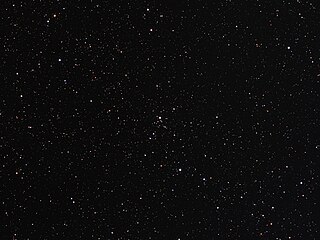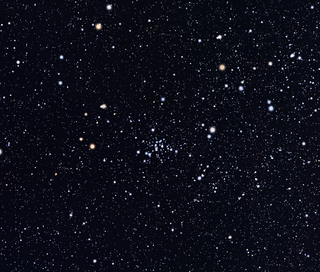
Scutum is a small constellation. Its name is Latin for shield, and it was originally named Scutum Sobiescianum by Johannes Hevelius in 1684. Located just south of the celestial equator, its four brightest stars form a narrow diamond shape. It is one of the 88 IAU designated constellations defined in 1922.

The Wild Duck Cluster is an open cluster of stars in the constellation Scutum. It was discovered by Gottfried Kirch in 1681. Charles Messier included it in his catalogue of diffuse objects in 1764. Its popular name derives from the brighter stars forming a triangle which could resemble a flying flock of ducks. The cluster is located just to the east of the Scutum Star Cloud midpoint.

Messier 23, also known as NGC 6494, is an open cluster of stars in the northwest of the southern constellation of Sagittarius. It was discovered by Charles Messier in 1764. It can be found in good conditions with binoculars or a modestly sized telescope. It is in front of "an extensive gas and dust network", which there may be no inter-association. It is within 5° the sun's position so can be occulted by the moon.

Messier 50 or M 50, also known as NGC 2323 or the Heart-shaped Cluster, is an open cluster of stars in the constellation Monoceros. It was recorded by G. D. Cassini before 1711 and independently discovered by Charles Messier in 1772 while observing Biela's Comet. It is sometimes described as a 'heart-shaped' figure or a blunt arrowhead.

Messier 62 or M62, also known as NGC 6266 or the Flickering Globular Cluster, is a globular cluster of stars in the south of the equatorial constellation of Ophiuchus. It was discovered in 1771 by Charles Messier, then added to his catalogue eight years later.

Messier 67 and sometimes called the King Cobra Cluster or the Golden Eye Cluster is an open cluster in the southern, equatorial half of Cancer. It was discovered by Johann Gottfried Koehler in 1779. Estimates of its age range between 3.2 and 5 billion years. Distance estimates are likewise varied, but typically are 800–900 parsecs (2,600–2,900 ly). Estimates of 855, 840, and 815 pc were established via binary star modelling and infrared color-magnitude diagram fitting.

Messier 75 or M75, also known as NGC 6864, is a giant globular cluster of stars in the southern constellation Sagittarius. It was discovered by Pierre Méchain in 1780 and included in Charles Messier's catalog of comet-like objects that same year.

Messier 93 or M93, also known as NGC 2447 or the Critter Cluster, is an open cluster in the modestly southern constellation Puppis, the imagined poop deck of the legendary Argo.

NGC 2204 is an open cluster of stars in the Canis Major constellation. It was discovered by the German-English astronomer William Herschel on 6 February 1785. The cluster has an integrated visual magnitude of 8.6 and spans a diameter of 10.0′. Resolving the individual member stars is a challenge with a 10 to 12-inch amateur telescope. It is located at a distance of approximately 13,400 light years from the Sun. The cluster shows a mean radial velocity of +91.38±0.30 km/s relative to the Sun, and is orbiting the inner galactic disk region about 1 kpc below the galactic plane.

NGC 6242 is an open cluster of stars in the southern constellation Scorpius. It can be viewed with binoculars or a telescope at about 1.5° to the south-southeast of the double star Mu Scorpii. This cluster was discovered by French astronomer Nicolas-Louis de Lacaille in 1752 from South Africa. It is located at a distance of approximately 4,350 ly (1,335 pc) from the Sun, just to the north of the Sco OB 1 association. The cluster has an estimated age of 77.6 million years.
NGC 6738 is an astronomical feature that is catalogued as an NGC object. Although listed as an open cluster in some astronomical databases, it may be merely an asterism; a 2003 paper in the journal Astronomy and Astrophysics describes it as being an "apparent concentration of a few bright stars on patchy background absorption".

NGC 6208 is an open cluster in the southern constellation of Ara. With an age of 1.17 Gigayears, it is one of the oldest known open clusters.

IC 4651 is an open cluster of stars located about 2,900 light years distant in the constellation Ara. It was first catalogued by John Louis Emil Dreyer in his 1895 version of the Index Catalogue. This is an intermediate age cluster that is 1.2 ± 0.2 billion years old. Compared to the Sun, the members of this cluster have a higher abundance of the chemical elements other than hydrogen and helium. The combined mass of the active stars in this cluster is about 630 times the mass of the Sun.

NGC 637 is an open cluster of stars in the northern constellation of Cassiopeia, positioned about 1.5° to the WNW of the star Epsilon Cassiopeiae. The cluster was discovered on 9 November 1787 by German-born English astronomer William Herschel. It is located in the Perseus Arm of the Milky Way, at a distance of approximately 7.045 kilolight-years from the Sun. The cluster is small but compact, and is readily visible in a small telescope.

NGC 1817 is an open cluster of stars in the constellation Taurus. It was discovered by English astronomer William Herschel in February 1784. With an apparent magnitude of 7.7 and spanning 9.3 arc minutes across the sky, it is separated from the NGC 1807 cluster by just 26 arc minutes. Indeed, the two may actually be parts of a single extended cluster.

NGC 433 is an open cluster in the northern constellation of Cassiopeia, located at a distance of 6,500 light years from the Sun. It was discovered on September 29, 1829, by John Herschel, and was described by John Dreyer as "cluster, small, a little compressed." The cluster is considered on the poor side, with only 12 stars above magnitude 16. It has a linear diameter of 26.3 ly, with around 479 times the mass of the Sun and an age of 65 million years.

NGC 4349 is an open cluster in the constellation Crux. It was discovered by James Dunlop in 1826. It is located approximately 7,000 light years away from Earth.

NGC 4103 is an open cluster in the constellation Crux. It was discovered by James Dunlop in 1826. It is located approximately 5,000 light years away from Earth, in the Carina-Sagittarius arm.


















